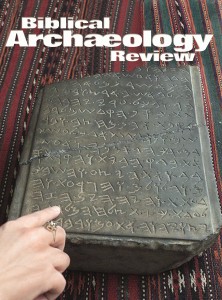Biblical Archaeology Review, May/June 2003
Special Section
The Paleographer: Demonstrably a Forgery
Was it too good to be true? In recent months, the world learned of an inscribed tablet apparently written by Jehoash, the ninth-century B.C.E. king of Judah. But almost immediately, questions were raised about its authenticity. After examining the text of The Jehoash Inscription, Frank Moore Cross,...Read more ›
The Linguist: Hebrew Philology Spells Fake
The language of The Jehoash Inscription is fake. It is not idiomatic ancient Hebrew but rather a perversion of it. If authentic, it would be a phenomenal find. But clearly it is not a genuine artifact. To be declared authentic, any inscription that has not been excavated...Read more ›
Fool The Experts
Make a convincing fake and win $10,000!
Object: To make a facsimile of The Jehoash Inscription that will fool the experts. The recently disclosed Jehoash Inscription has divided the scholarly world. If it is authentic, it would be the first royal Israelite inscription ever found. Some experts, primarily epigraphers and linguists, are sure it...Read more ›
Features
Mounds of Mystery
Where the Kings of Judah Were Lamented
At the beginning of the 20th century, when Jerusalem, still centered around its ancient core, was surrounded by agricultural land and orchards, 20 mysterious earth-and-stone mounds rose above the city’s western horizon, clearly visible from afar. Today several of them have disappeared, flattened by excavation or by...Read more ›
The “Three Shekels” and “Widow’s Plea” Ostraca: Real or Fake?
One of the most astounding inscriptions to surface in recent years records a donation of three shekels to the Temple of the Lord (Beyt Yhwh) in Jerusalem. It is written on a broken piece of pottery (called an ostracon) and dates somewhere between the ninth and seventh...Read more ›
Spending Your Way through Jewish History
Ancient Judean Coins Tell Their Story
Coins, ancient and modern, facilitate the flow of commerce. But their usefulness does not end there. Coins are also effective tools of mass communication—to disseminate propaganda. This was especially important in the ancient world, before television or even the printing press. Thanks to this second role, coins...Read more ›

